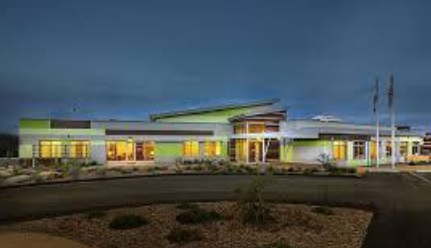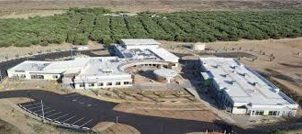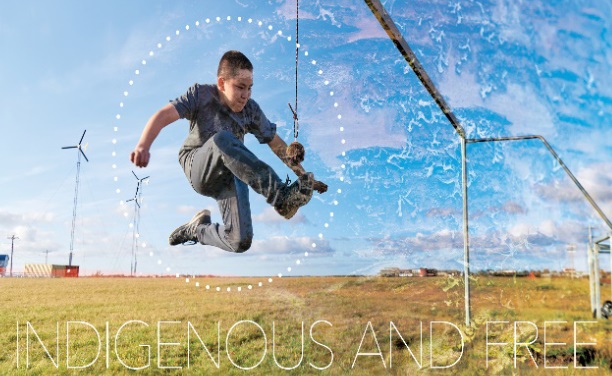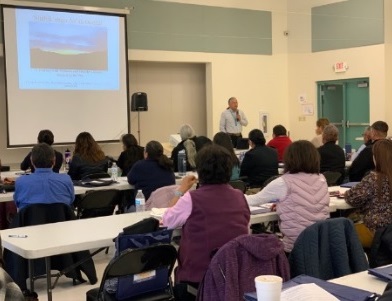2020 Success Stories
These examples of disease prevention and health promotion highlights and accomplishments from the field are meant to inspire action to make positive changes to support wellness.
California Area Highlight – Desert Sage YRTC

Introduction-Project History: Desert Sage Youth Wellness Center is one of 12 IHS Youth Regional Treatment Centers providing American Indian and Alaska Native youth residential treatment services for substance abuse and co-occurring disorders. As a federally operated facility in the California Area, Desert Sage Youth Wellness Center is accredited by the Joint Commission. Desert Sage assists youths by meeting them where they are and helping them to discover their unique path to recovery. To support youth in their individual paths towards wellness, the treatment programs use traditional knowledge and culture to focus on the impact that nutrition and healthy eating have during recovery, as poor nutritional status is shown to impede physical and psychological healing. Additionally, optimal nutrition and healthy eating support prevention of type 2 diabetes, which is shown to be nine times higher in American Indian and Alaska Native youth.
Project Description: In response to the central role that nutrition and healthy eating have in healing and in the prevention of type 2 diabetes, efforts were launched to enhance nutrition interventions at Desert Sage. This year, staff began collaborating on expanding clinical nutrition interventions, including implementing nutrition assessments and nutrition counseling, developing a nutrition and diabetes prevention education curriculum, enhancing nutrition content of meals served, and operationalizing a diet manual that includes therapeutic diets. The project aims to support the residents' clinical care by resolving or improving nutritionally impacted conditions, with dietary interventions based on recognized standards. The overall objective is to counter poor nutritional status, which can lead to vitamin deficiencies and a host of health issues. The project promotes the positive impact that optimal nutrition and healthy eating have on clinical outcomes. This includes addressing that poor nutrition can be a component of substance abuse, and that addictive substances can contribute a host of nutrition deficiencies. This collaboration supports clinical services, which are rooted in culturally relevant and holistic care.
For more information, watch the overview video:
Desert Sage Youth Wellness Center – The California Youth Regional Treatment Center

Contact:
Beverly Calderon, MS, RDN, CDCES, NBC-HWC
Nutrition Consultant
Indian Health Service California Area Health Promotion/Disease Prevention
Phone: 760-735-6884
Virtual Fitness Events during the Covid-19 Pandemic

Introduction–Project History: With essential social distancing guidelines implemented in the Navajo Nation, the Health Promotion/Disease Prevention (HP/DP) office for the Navajo Area Indian Health Service (NAIHS) has successfully transitioned to hosting virtual fitness events. With rising physical and mental health challenges associated with the pandemic, HP/DP fitness specialists have encouraged their team to adapt new strategies to promote physical fitness in their community. Due to these changes, the HP/DP office plans to host this year’s annual Veterans Day Run virtually.
Project Description: During Breast Cancer Awareness Month, the HP/DP led virtual fitness events with 168 participants. Many members of the community were grateful to bring awareness to breast cancer, and numerous participants expressed their excitement for the option to participate virtually. The NAIHS office plans to follow suit and host a virtual Veterans Day Run in the Navajo Area. Local challenges will include various options: a 1-mile run, a 5K, and a 10K. Participants will receive certificates of completion as well as medals.
Summary: While the transition to virtual programming was an adjustment, virtual events have been widely successful. Community members in rural areas are now able to participate more easily at home, while virtual events have been able to reach more people. Also, recorded virtual sessions have allowed individuals who are not regularly able to attend fitness sessions during the day to participate in workouts in the evenings. Virtual participants interested in friendly competition are also able to connect through smart watches and fitness apps. The HPDP office believes the Veterans Day Run will be the beginning of a widely successful continuation of virtual fitness events.
Contact: Elfreida Barton, Fitness Specialist
Navajo Area HPDP Office
Phone: 928-871-1394
Alaska Native Tribal Health Consortium Launches Vaping Prevention Campaign for Parents and Teens
By Crystal Meade

Introduction: Cigarette smoking among Alaska Native teens decreased significantly from 62% in 1995 to 18% in 2017. However, in less than a decade, vaping rates among youth (including Alaska), have risen drastically. Data also shows that teens who reported not smoking cigarettes are now vaping (Alaska Youth Risk Behavior Survey, 2017). This trend is of concern for Alaska because it has the potential to stall or reverse significant progress made in tobacco prevention.
Project Description: In response to the increasing use of vaping among youth, the Alaska Native Tribal Health Consortium (ANTHC) launched a vaping prevention campaign that includes a comprehensive website with resources for both youth and parents. Website resources include harms of vaping, quit vaping, and to help parents talk to their children about the risks associated with vaping. The campaign also includes digital and print media that are shared through various social media platforms such as Facebook, Instagram, and Snapchat.
The campaign titled Indigenous and Free capitalizes on Alaska Native pride and empowers youth to be vape-free. The campaign also highlights traditional activities and practices within Alaska Native culture, including harvesting, traditional dance, and Native Youth Olympics. The campaign hopes to share the message that commercial tobacco use (including vaping) is not safe, and is not part of Alaska Native culture.
ANTHC vaping prevention resources
For more information, please call us at 907-729-4343, or email the ANTHC Tobacco Prevention Program.

Crystal Meade, born and raised in Anchorage, is part Tsimshian Indian with family originating from Southeast Alaska (Ketchikan/Metlakatla). She has worked for ANTHC since 2005, and has been in various positions, including Clinical Coordinator for the Growing Up Tobacco-Free Project, the Tobacco Cessation Coordinator, and has assisted with Phase 2 of the Motivating Tobacco Cessation in Pregnant Alaska Native Women Study. Currently, she serves as the Program Manager for the ANTHC Tobacco Prevention Program. A graduate of the University of Alaska Anchorage, she is currently working on her MPH.
Chinle Service Unit Health HPDP Program

Introduction: In the fall of 2004, two Chinle Service Unit Health Promotion/Disease Prevention (HPDP) program staff members traveled to the field to conduct a prevention presentation. A Navajo Elder approached the staff and said that "Navajo teachings should be used to teach about health and wellness, since we grew up with it and we know it. We just don’t teach it to our people anymore." In response to the elder’s feedback, the Navajo HPDP program decided to use Navajo teachings on health and wellness to develop the Navajo Wellness Model Curriculum.
Project Description: The Navajo Wellness Model uses a social ecological approach of public health including teachings from Navajo philosophy. The Model talks about following the journey of the sun --- from sun up to sun down there are teachings Navajo people are supposed to follow, like running toward the sun in the morning, self-care, and taking care of the household and pets. The Model is designed to increase awareness, knowledge, and understanding among health care and public health providers of the core Navajo teachings about personal and family health, healthy communities, and a healthy environment. Since the inception of the model, we have trained over 200 health care and public providers across the Navajo Nation.
In 2019, a team of Traditional Healers, HPDP staff, and community members assembled to edit the Navajo Wellness Model. The team has been diligently working together to get the Model ready to use this upcoming winter. We would like to acknowledge the team of editors; Charlotte Hadley, Cassandra Allen, Annette Gonnie, Roland Begay, Woodie Tsosie, Darlene Begay, Ernest H.Begay, Neva Kayaani, Regina BlueEyes, Rich Begay, Chelsea Kettering, Carol Leonard, and Shawnell Damon.
In January 2020, the Navajo Area HPDP program hosted the Navajo Wellness Model training of 113 participants with Johnson Dennison and Richard Begay conducting training in both Navajo and English languages. We received overwhelming positive feedback from participants, and both the Navajo Wellness Model and participants were acknowledged by the the Honorable Amber Crotty who dropped in on the training.
Participant Feedback
"Mr. Dennison is humble, amazing, and so descriptive in all of his teachings...I am going to enroll in a class to learn to write and read the Navajo language."
"Mr. Begay is an eloquent speaker, expelling positive energy, and motivating us with the translation from Navajo to English."
"(I liked) the resources of traditional people and medicine people in that meeting room, the wealth of knowledge."
"This was my first opportunity attending the almost week long training, and (I) walked away feeling refreshed, reinvigorated, and very much inspired."
Summary: We are thankful for the feedback from the elder who reminded us to use our own traditional teaching to empower our people to support personal, family, and community health.
Contact: Shawnell Damon, MPH, MSc
HP/DP Coordinator and Epi Lead
Navajo Area HP/DP Program
P.O. Box 9020 Window Rock, Arizona 86515


